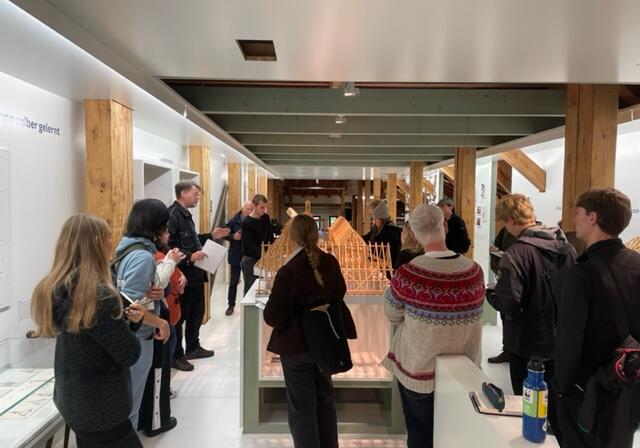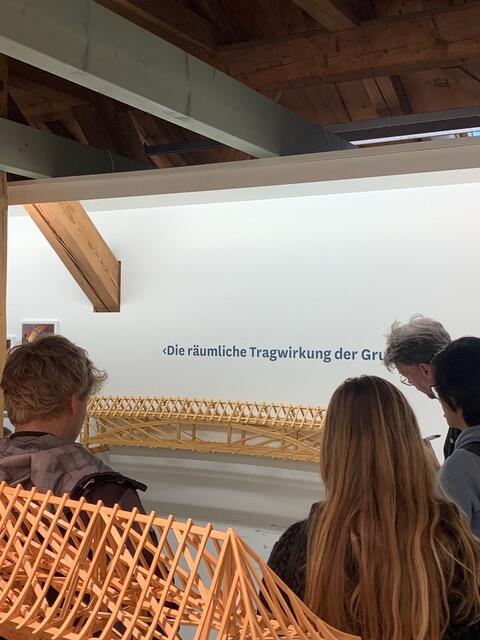Bridging the gap – Göteborg zu Besuch
Bridging the gap – Göteborg zu Besuch
22.11.2023

Architektur-Studierende der Chalmers University of Technology Gothenburg geben Einblick in ihren Besuch im Grubenmann Museum
Combining studies with real-world experiences can be a fantastic and enriching journey, as it was for us from the Architecture and Engineering Program at Chalmers University of Technology in Gothenburg, Sweden, during our visit to Teufen.
Our first thought when stepping into the museum was: «This building’s primary purpose was not to be a museum.» This actually fit the theme of our study trip perfectly, to reuse buildings in which their original purpose disappears, instead of demolishing them. Up on the second floor, the house itself, with its exposed structural system, was the first example we got to study. We learned about primary and secondary load-bearing and the innovative fastenings of the time used to transfer loads.
Bridging the gap between theory and practice
One striking aspect of the Grubenmann family’s legacy is their approach to learning construction technology. In contrast to us as architecture students today, who primarily learn through theoretical education, they acquired their knowledge through practical experience. This hands-on approach allowed them to develop an intimate understanding of construction techniques and materials, emphasizing the importance of learning through doing.
The approach of learning was an iterative process that spanned generations. Knowledge was passed down from one family member to the next, resulting in a continuous refinement of construction techniques. Museums like Grubenmann are essential as they provide a window into this historical iterative learning process. Some of the Grubenmann’s constructions no longer exist, making it impossible to study them in reality. The scale models in the museum become invaluable tools for us as visitors, offering a glimpse into the past that would otherwise be lost.
The models
One model that stayed in our minds was a church roof, where a bow-shaped wooden beam is used to support the roof’s weight without the need for pillars inside the church. The long sides of the church don’t require additional support because the short walls and the arch effectively can carry the load. Such a clever solution to combine a bridge construction into a church roof.
While the scale models of Grubenmann’s constructions provide invaluable insights, it is essential to view them with a critical eye. Model builders may not have replicated the real buildings and bridges with absolute precision, as they are, after all, representations. However, despite potential inaccuracies, these models serve as fantastic educational tools. As students, we could ask questions to better comprehend the principles of construction. As well as they enable our teachers to explain the construction of structures in a pedagogical way, bridging the gap between theoretical knowledge and practical understanding.
Embracing failure as a path to knowledge
Another noteworthy aspect that the Grubenmann family’s journey reminded us about is the willingness to embrace failure as an inherent part of the learning process. With limited knowledge, they had to experiment and mistakes led to valuable insights and progress in the construction industry. This serves as a reminder for us students to be humble in the face of uncertainty and to see it as a driving force for learning and growth. We must not forget that failure is a stepping stone to success.
The idea that someone could acquire such extensive knowledge without a formal engineering or master builder education felt quite remarkable to us, as present-day engineering and architecture students. Grubenmanns iterative learning process and the persistent drive to create more advanced and more optimized constructions after each project left motivation and strong impression on us.
Engineering and architecture as living subjects
In conclusion, our journey to the museum was a memorable and inspiring experience. It gave us a deeper understanding of architecture and construction engineering and how innovative solutions have shaped the world’s bridges. We could see the connection between our studies and the real world in a way that enriches our upcoming years in school and future careers. It was a reminder that engineering and architecture are living subjects that continue to evolve and shape our world. We left the museum with a sense of admiration and humility toward the creative and technical geniuses who paved the way for the impressive bridges we see today.
Authors: Linnea, Madelene, Molly & Tone Bergh

